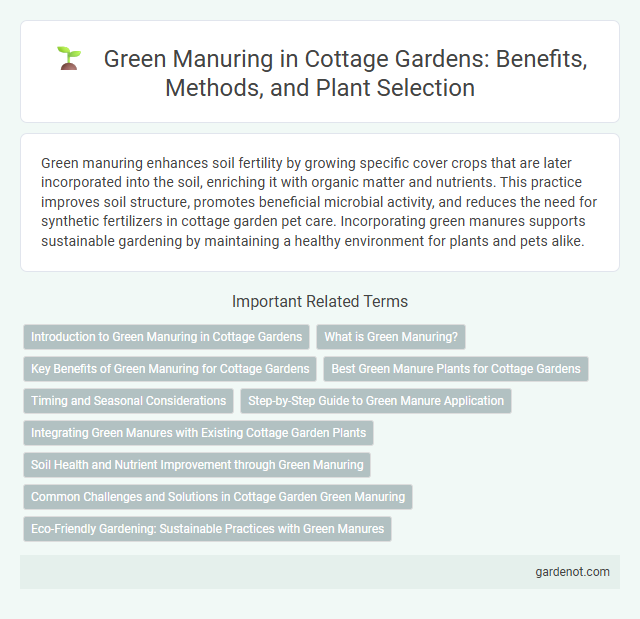Green manuring enhances soil fertility by growing specific cover crops that are later incorporated into the soil, enriching it with organic matter and nutrients. This practice improves soil structure, promotes beneficial microbial activity, and reduces the need for synthetic fertilizers in cottage garden pet care. Incorporating green manures supports sustainable gardening by maintaining a healthy environment for plants and pets alike.
Introduction to Green Manuring in Cottage Gardens
Green manuring in cottage gardens involves growing specific cover crops such as clover, vetch, or rye to improve soil fertility naturally. These plants enhance soil structure, increase organic matter, and fix nitrogen, promoting healthier plant growth without chemical fertilizers. Implementing green manuring supports sustainable gardening practices while boosting soil microbial activity and nutrient availability in small-scale garden beds.
What is Green Manuring?
Green manuring is the practice of growing specific cover crops, such as clover, vetch, or mustard, and then plowing them into the soil to improve its fertility and organic matter content. These plants enhance nutrient levels, particularly nitrogen, promote soil structure, and increase microbial activity in cottage gardens. Incorporating green manures reduces the need for synthetic fertilizers and supports sustainable gardening practices.
Key Benefits of Green Manuring for Cottage Gardens
Green manuring enriches cottage garden soil by increasing organic matter and improving nutrient availability, promoting healthier plant growth. This practice enhances soil structure and moisture retention, reducing erosion and the need for synthetic fertilizers. Integrating green manure crops supports beneficial soil microbes, boosting overall garden biodiversity and sustainability.
Best Green Manure Plants for Cottage Gardens
Legumes such as crimson clover, hairy vetch, and field peas are among the best green manure plants for cottage gardens due to their nitrogen-fixing abilities, which enrich the soil naturally. Buckwheat and mustard serve as excellent fast-growing green manure crops that suppress weeds and improve soil structure by increasing organic matter. Incorporating these plants into cottage gardens boosts soil fertility, enhances moisture retention, and supports sustainable gardening practices.
Timing and Seasonal Considerations
Green manuring in a cottage garden is most effective when timed to coincide with the off-season, typically during late summer to early fall, allowing cover crops like clover or vetch to enrich the soil before winter. Planting green manure crops in autumn provides ample time for biomass growth and nitrogen fixation, improving soil fertility for spring planting. Removing or incorporating the cover crops into the soil in early spring ensures optimal nutrient release and soil structure enhancement for the upcoming growing season.
Step-by-Step Guide to Green Manure Application
Green manuring in a cottage garden involves selecting nitrogen-fixing plants like clover or vetch, sowing them after the main crop harvest to enrich the soil naturally. The green manure crop should be allowed to grow until flowering, then cut and incorporated into the soil to enhance organic matter and nutrient content. This simple, eco-friendly process promotes soil fertility, improves structure, and supports sustainable garden productivity.
Integrating Green Manures with Existing Cottage Garden Plants
Integrating green manures such as clover, vetch, and rye into existing cottage garden plants improves soil fertility by fixing nitrogen and enhancing organic matter. These cover crops suppress weeds and reduce erosion while complementing flowers, herbs, and vegetables commonly found in cottage gardens. Selecting green manure species with compatible growth habits ensures minimal competition and promotes a balanced, nutrient-rich environment for perennial and annual plants.
Soil Health and Nutrient Improvement through Green Manuring
Green manuring enhances soil health by incorporating nutrient-rich cover crops like clover, vetch, and rye into the soil, boosting organic matter and microbial activity. This process improves soil structure, water retention, and nutrient availability, particularly nitrogen fixation, which benefits subsequent cottage garden plants. Regular green manuring cycles reduce the need for chemical fertilizers, promoting sustainable nutrient management and long-term soil fertility.
Common Challenges and Solutions in Cottage Garden Green Manuring
Common challenges in cottage garden green manuring include poor soil compatibility, slow decomposition, and nutrient imbalances. Solutions involve selecting suitable green manure crops like clover or vetch, incorporating them at the optimal growth stage, and regularly testing soil nutrient levels to adjust application rates. Proper timing and crop rotation enhance soil fertility and structure, minimizing pest and weed issues.
Eco-Friendly Gardening: Sustainable Practices with Green Manures
Green manuring enhances soil fertility by incorporating cover crops such as clover, legumes, and buckwheat into cottage gardens, promoting natural nutrient cycling and organic matter enrichment. This eco-friendly practice reduces reliance on synthetic fertilizers, supporting sustainable gardening through improved soil structure, moisture retention, and increased biodiversity. Implementing green manures aligns with sustainable horticulture principles, fostering healthy, resilient garden ecosystems while minimizing environmental impact.
Green manuring Infographic

 gardenot.com
gardenot.com